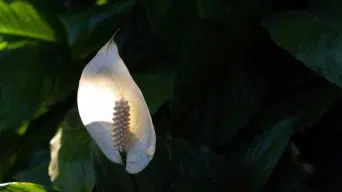Peace Lily root rot, caused by fungi like Fusarium and Pythium, results from overwatering, poor drainage, fungal diseases, or root damage. Early signs include yellowing, wilting, brown spots, mushy roots, stunted growth, and a bad smell. To treat, remove affected roots, rinse, dry, disinfect the pot, and repot in sterile soil. Prevent root rot with proper watering, well-drained soil, and good airflow.
Peace Lily plants are elegant houseplants that can brighten up any room.
But even the most diligent gardener can run into problems from time to time, and one of the most common problems Peace Lily growers face is root rot.
Peace Lily root rot is a severe problem that can kill your plant if left untreated, but there are some things you can do to save your plant if you catch it early enough.
In this guide, we’ll show you how to identify and treat Peace Lily root rot and prevent it from happening in the first place.
What is Root Rot
Root rot is a fungal disease that affects the roots of the plant.
It is caused by various fungi, including Fusarium and Pythium species.
These fungi live in the soil and enter plant roots through wounds or natural openings.
Once inside the plant, they grow and spread, causing the roots to rot.
This can damage the plant’s ability to absorb water and nutrients, eventually leading to death.
Root rot is often challenging to detect until it is too late, as the symptoms mimic those of other problems.
As such, it is essential to be aware of the signs of root rot and to take steps to prevent it.
What Causes Root Rot in Peace Lilies
A few different things can cause Peace Lily root rot.
The most common causes are:
1. Overwatering
Overwatering is the primary culprit behind Peace Lily root rot, a prevalent issue among these plants.
Originating from tropical rainforests, Peace Lilies naturally thrive in humid conditions accompanied by regular rainfall, where their roots consistently experience moisture.
However, as houseplants, they often contend with drier environments, demanding less water than their native habitat.
Excessive watering disrupts this balance, initiating root rot and ultimately leading to the plant’s demise.
When Peace Lilies are overwatered, their roots struggle to access the necessary oxygen for proper functionality, resulting in their deterioration and the eventual demise of the entire plant.
2. Poor Drainage
Inadequate drainage is a frequent culprit behind Peace Lily root rot.
These plants flourish in well-draining soil. Without proper drainage, roots can become waterlogged and subsequently decay.
Confirming that your pot is equipped with drainage holes at the base is crucial to optimize conditions.
Without these openings, water will accumulate in the pot’s base, leading to root rot.
3. Fungal Disease
Peace Lily root rot often results from fungal diseases, with Fusarium and Pythium being the primary culprits.
These fungi, thriving in damp conditions, target the plant’s roots, inducing rot.
Since Fusarium and Pythium are soil-borne, eliminating them once a plant is infected poses a considerable challenge.
4. Root Damage
Root damage frequently leads to root rot in Peace Lilies plants.
These delicate plants are particularly prone to root vulnerability.
Roots can incur damage through various means, such as physical stress (for instance, being stepped on), exposure to chemicals (like fertilizers or pesticides), or biological threats (such as nematodes or other pests).
When the roots of a Peace Lily sustain damage, they become susceptible to fungal infections, ultimately resulting in root rot.
Identifying Signs of Peace Lily Root Rot
To save your plant, you need to be able to identify the early signs of root rot.
Unfortunately, it’s often too late when most gardeners realize there’s a problem, highlighting the importance of proactive care.
Here are some early symptoms that your Peace Lily plant has root rot:
Yellow Leaves
One of the first signs that something is wrong with your plant is when the leaves start to turn yellow.
This is usually a sign of stress and can be caused by several factors, including root rot.
When roots are damaged, they can’t effectively take up water and nutrients from the soil. This lack of nutrients causes the leaves to turn yellow.
Wilting Leaves
If your Peace Lily leaves are wilting, it’s a sign that something is wrong with the roots.
When roots are damaged, they can’t take up water from the soil. This lack of water causes the Peace Lily leaves to wilt.
Brown or Black Spots on Leaves
If you see black or brown spots on your plant’s leaves, it’s another sign that something is wrong with the roots.
These black spots are caused by a fungus called Pythium, which thrives in wet conditions.
Pythium is a soil-borne fungus, so getting rid of it once it’s infected a plant can be challenging.
Mushy Roots
If your plant’s roots are mushy or rotting, it’s a sure sign that it has root rot.
The plant is in serious trouble and will likely die if the root rot is not treated.
Stunted Growth
If the plant is not growing as it should, it’s another sign that something is wrong.
When roots are damaged, they can’t take up nutrients from the soil as effectively.
This lack of nutrients causes the plant to grow more slowly than it should.
Bad Smell
If your plant has root rot, you may notice a bad smell coming from the roots.
This is because the roots are breaking down and rotting.
If you notice a terrible odor, it’s a sure sign that your plant has root rot and needs to be treated immediately.
Effective Treatment for Peace Lily Root Rot
You must take action immediately if you notice any of the above signs.
Peace Lily root rot is a severe problem; if it’s not treated, it will kill the plant.
Here is a step-by-step guide to treating root rot:
1. Remove the Plant and Inspect the Roots
The first step is to remove the Peace Lily plant from the pot and examine the roots.
If you see any mushy or black roots, cut them off with a sharp knife.
Be sure to dispose of the infected roots in the trash so they don’t infect other plants.
Make sure to sterilize your tools before using them on your plant.
2. Rinse Roots With Clean Water
Once you’ve removed the affected roots, rinse the remaining roots with clean water.
This will help to remove any dirt or debris that may be on the roots.
It will also help to remove any fungal spores that may be present.
3. Allow Roots to Dry Completely
Once you’ve rinsed the roots, allow them to dry completely.
This may take a few hours or even a day or two.
The roots must be completely dry before replanting the plant.
4. Clean and Disinfect the Pot
Once the roots are dry, it’s time to clean and disinfect the pot.
You can do this by soaking the pot in a solution of one part bleach and ten parts water for 30 minutes.
After 30 minutes, rinse the pot with clean water and let it air dry.
5. Repot the Plant in Fresh, Sterile Soil
Once the pot and roots are dry, it’s time to repot the plant in fresh, sterile soil.
Use a drainage hole pot to allow excess water to drain out.
It’s also essential to use sterile soil.
You can purchase a sterile potting mix or make your own by mixing equal parts perlite and peat moss.
6. Water the Plant Carefully
Once you’ve replanted the plant, water it carefully.
Be sure to water the soil, not the leaves.
It’s also important not to overwater the plant.
Allow the top inch of soil to dry out before watering again.
Watering the plant too often will encourage the growth of the fungus that causes root rot.
7. Monitor the Plant’s Progress
Once you’ve replanted the plant, keeping an eye on it is essential.
Check the roots periodically to ensure they are healthy and free of rot.
If you see any signs of root rot, remove the affected roots and follow the steps above.
Your plant should recover from root rot and continue to thrive with proper care.
Measures to Prevent Peace Lily Root Rot
Preventing Peace Lily root rot is all about providing the right growing conditions.
These tropical plants prefer warm, humid environments and well-drained soil.
Here are a few tips to help you create the perfect environment for your Peace Lily:
1. Place Your Peace Lily in Bright Indirect Light
Peace lilies thrive in bright, indirect light.
They will tolerate some direct sunlight, but too much sun can scorch the leaves.
If your peace lily is getting too much sun, you’ll notice the leaves start to turn yellow.
2. Water Your Peace Lily Regularly
Water your Peace Lily regularly to maintain its optimal moisture levels.
Peace lilies thrive when kept moist but not wet, promoting healthy growth and vibrant foliage.
Remember to water your plant when the top inch of soil is dry, gauging this by the pot’s weight.
If the pot feels light, indicating potential dryness, it’s time to provide hydration and prevent root rot.
3. Use a Well-Drained Soil
It’s crucial to use well-drained soil when growing Peace Lilies.
Soil that doesn’t drain well can lead to root rot.
Mix equal parts potting soil and perlite to ensure your peace lily has well-draining soil.
4. Use Pots With Drainage Holes
When potting your peace lily, use a pot with drainage holes.
This will help prevent the roots from sitting in water, leading to root rot.
5. Repot in Fresh Soil Every Year
Peace lilies should be repotted every year in fresh potting soil.
This will help to prevent the build-up of pests and diseases in the pot.
It will also give the roots a chance to grow, giving the plant fresh nutrients.
6. Fertilize Sparingly
Peace lilies don’t need a lot of fertilizer.
Fertilize your plant once a month during the growing season using a half-strength liquid fertilizer.
Be sure to flush the soil with water every few months to prevent the build-up of fertilizer salts.
7. Ensure Adequate Air Circulation
Peace lilies need good air circulation to prevent fungal diseases.
Be sure to place your plant in an area with some airflow.
You can also use a fan to circulate the air around your Peace Lily.
Final Thoughts
Peace lilies are beautiful, low-maintenance houseplants that purify the air and add a touch of elegance to any room.
But even the sturdiest Peace Lilies can succumb to root rot if they’re not cared for properly.
If you think your Peace Lily might be suffering from root rot disease, don’t despair.
While saving a plant that is already heavily affected can be challenging, it is possible.
You can bring your houseplant back to health with the proper care and attention.







